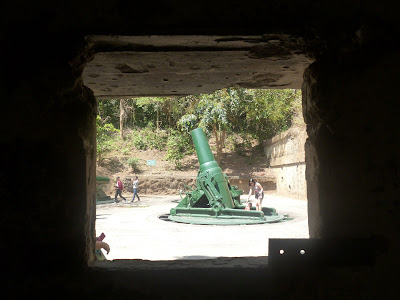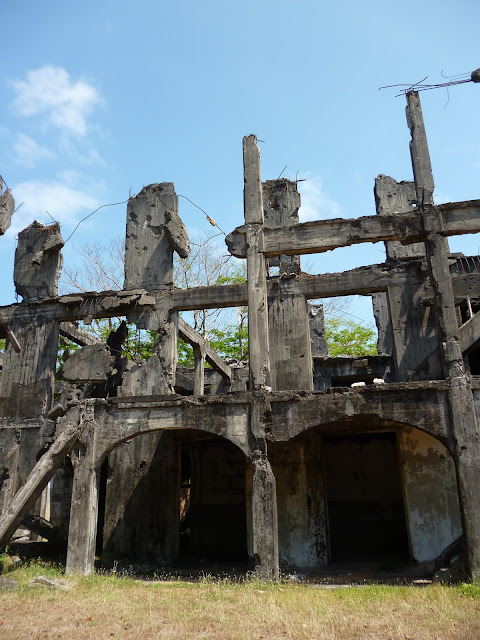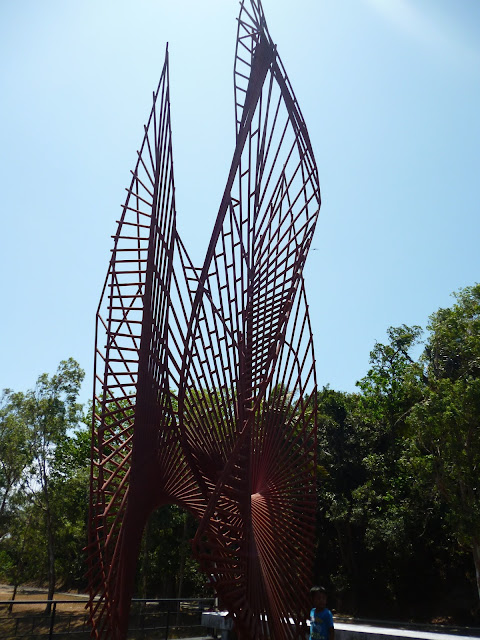I kind of feel like in my mind our trip to Manila is divided into three clear parts - the first half spent in the old town, the final in the new town and in between a historical trip to Corrigador.
Corrigador Island, or simply "Corrigador" as the locals all call it is an Island in the bay of Manila. The Philippines it pretty famous for it's island holiday, places like Cebu and lots of resorts. Well, Corrigador isn't that kind of island at all.
Corrigador is currently a historical reserve, but it has an amazing history - it was a military base first for the Spanish who lost it to the Americans who lost it to the Japanese in World War II - the Americans reclaimed it back from the Japanese a couple of years later. It's a small island, but its seen a lot of warfare.
As our guide said when we first arrived "I hope you guys all like history, it you don't, you're probably not going to have a good time" - fortunately I have a degree in history and I think one of the reasons I love to travel is I love history so much so I knew we were in the right place.
Rich took this photo of me next to our "bus" there are no vehicles on Corrigador apart from these buses, which they are a bus of sorts. They were actually modeled off the cable cars in San Fransisco and the reason they were chosen for tours is they are the same kind of vehicle that the US Army used to move their troops around the island on prior to the second world war.
The other thing about Corrigador is well - General MacArthur - he's obviously hugely important to the Filipino people as he was the military commander that lead the operation to take back first Corrigador, then Manila and then The Philippines and much of Asia from the Japanese. He's also a figures I've come across before in other parts of Asia, especially in Pusan in Korea.
We were the only non-Filipinos in our tour group and I think the only ones who didn't want a photo with the general!
We had a lot of stops on our tour - we started out with the site of an old gun embankment. It's always pretty hard visiting a place like this and realising the odds people are at when they are at war.
When we stopped here our guide explained to us that by the time the Japanese started bombing Corrigador, the guns on the island were hopelessly outdated. Guns like these had no impact on the planes that were being used in warfare at that time by the Japanese.
However, the Japanese could easily reach the American and Filipino soldiers on the island with their superior guns and technology - there's plenty of evidence of that.
Our next stop was the American and Filipino barracks on the island, well the ruins of the barracks, again these were pretty much completely destroyed before the island was surrendered to the Japanese. The American and Filipino troops spent months hiding in caves until they finally surrendered to the Japanese troops - which went against orders. They were meant to hold the island until until reinforcements arrived, but the General on the island decided he had no choice but to surrender.
Our next stop looks like just a lovely view, but in fact it was a stop to look at some current US/Filipino Military bases in this area on other islands. Including an island that has been turned into a base - like hacked down to become a floating military base...kind of weird.
The next stop on our tour was something a little more hopeful, a peace pavilion and this peace sculpture which was meant to be an ever burning flame (I think) - the sculpture didn't do much for me but its a worthy message (plus everything in the world isn't created for me!).
The domed building is the Pacific War Memorial, once a year, on the day the second world war ended in the Pacific the light hits that marble slab in the middle of the building.
Our guide told us that before the second world war, Corrigador was a place a lot of US soldiers wanted to be stationed as it was considered to be an island paradise. The island even included a golf course and a cinema. Some parts of the cinema have remained despite the bombing, our guide told us the last film to screen here was 'Gone with the Wind'. It must have been a pretty grand building in its day.
In the same spot was the Pacific war museum, which included a number of relics from the second world war and an incredible mosaic down the back with showed some of the main battles in this part of the world.
Our final stop before lunch was this rather cute light house, its a reproduction of one that was originally built in the same spot by the Spanish.
After ALL of this in just one morning - we had a bit of a break for lunch, that's right, we did all of this before 12!
After lunch in the only hotel in Corrigador (which was also where we spend the night) it was time for a bit more exploring. I took less photos on the second half of the day because it was a million degrees and I was struggling a bit!
Our first stop after lunch was another battery - which had some pretty beautiful views when you climbed up near the top.
The next stop was a memorial to the Filipino people who lost their lives fighting for their country, including those who had lost their lives in the second world war - but also freedom fighters who had lost their lives in wars against the Spanish and Americans.
There was also a special monument to Filipino women at the monument, which acknowledged the sacrifices of women in times of war.
Our next stop was the Japanese Memorial, our guide explained to us (as the only non-Filipinos on our tour) that this was a really a contentious place for a lot of Filipinos. The Japanese were the aggressors in World War II from the Filipino viewpoint and many people are unhappy about this memorial being established at all, however, our guide also told us as younger Japanese are often more accepting and open in accepting what happened in the second World War, the relationship between Filipinos and Japanese is being slowly healed.
The Japanese memorial was in a beautiful spot, this spot was chosen after an old photograph was found in a thrift shop or yard sale or something similar in the USA of Corrigador. In the photograph, a US solider was standing near a sign that said Japanese Cemetery. They placed the memorial on the site of the old cemetery.
Our very last stop for the day was Malinta Tunnel, we went and saw the light and sound show but we didn't take any photos inside. The light and sound show was pretty impressive though, it included real life footage of events leading up to the second world war, voice recordings and a bunch of figures to tell the story of the events leading up to the invasion and surrender of Corrigador.
The most fascinating thing about the Malinta tunnel is that US and Filipino troops hid in this tunnel for months until they finally had to surrender to the Japanese, against the orders of those higher up in the US army that wanted them to hold Corrigador for a few more months until reinforcements arrives.
Phew! So that's it for our first day in Corrigador - day two was much more relaxed, but for now, let's finish off with a picture of the view from our hotel room.
Also I know I've been a little quiet on the blogging front lately, everything has just been so busy! I'm hoping to be around a little more now though x




















































2 comments:
Wow, what an interesting historical place. Totally fascinating and so informative. I really enjoyed reading this!x
Hi Trees very nice trip!! beautiful photos too... :)
Would you like to follow each other on GFC+FB+Twitter and G+?
Let me know in my blog leaving a comment so I can follow back and take part to my Contest. Thank you.
SUMMER CONTEST That’s amore ♥ ♥ ♥
♥ ♥ FB
♥ Twitter
Post a Comment